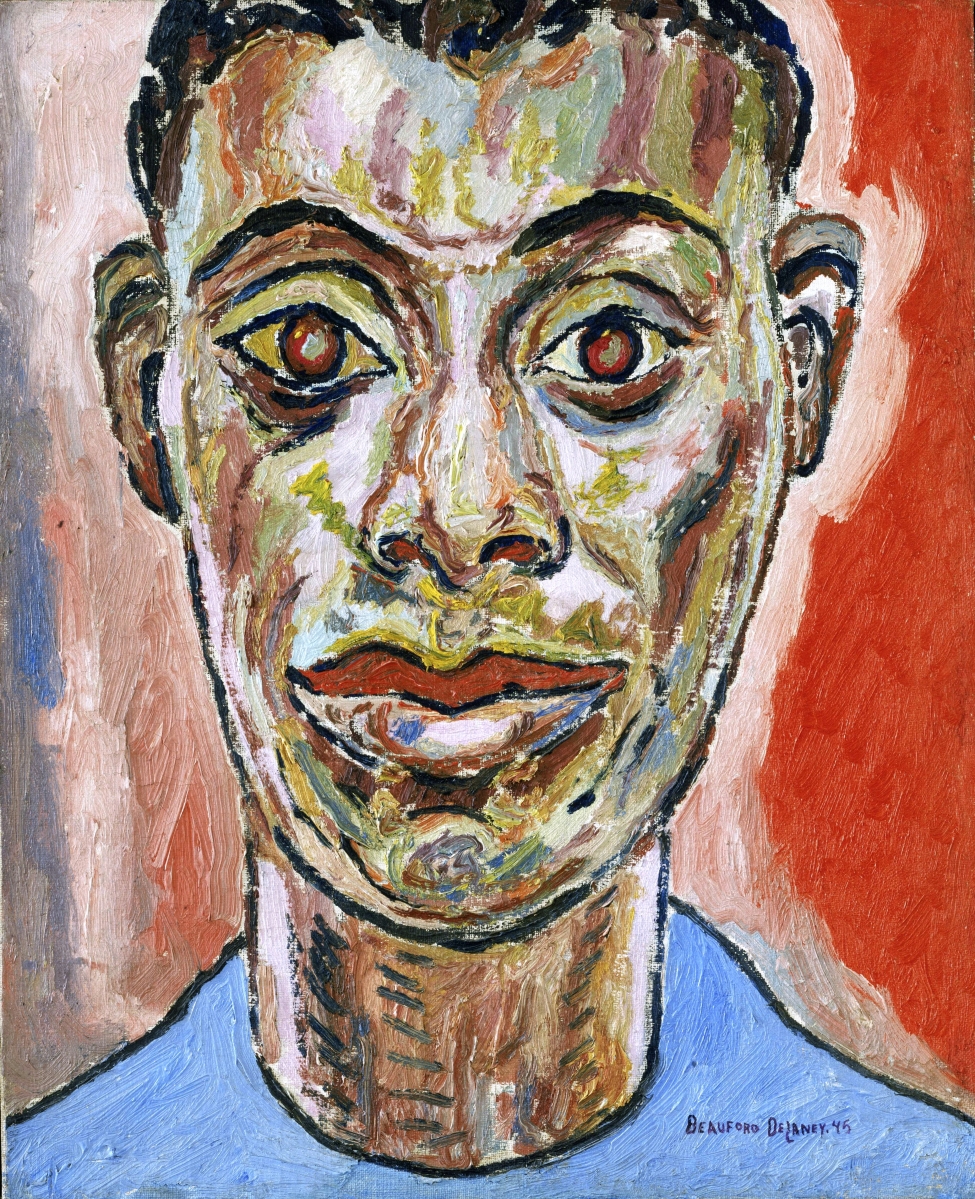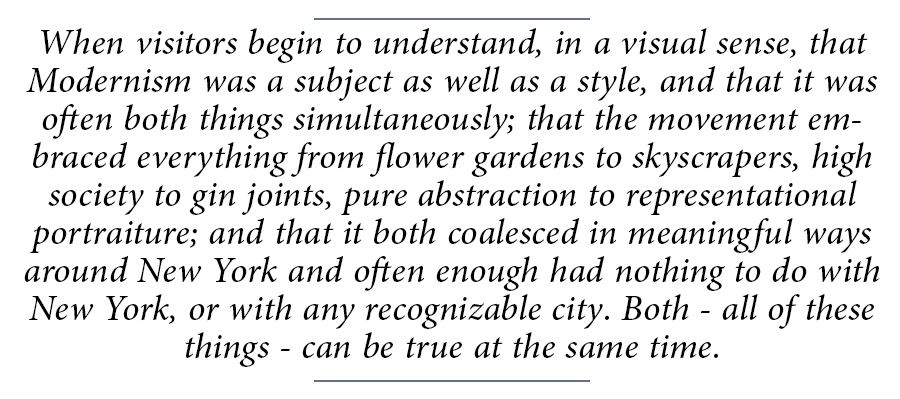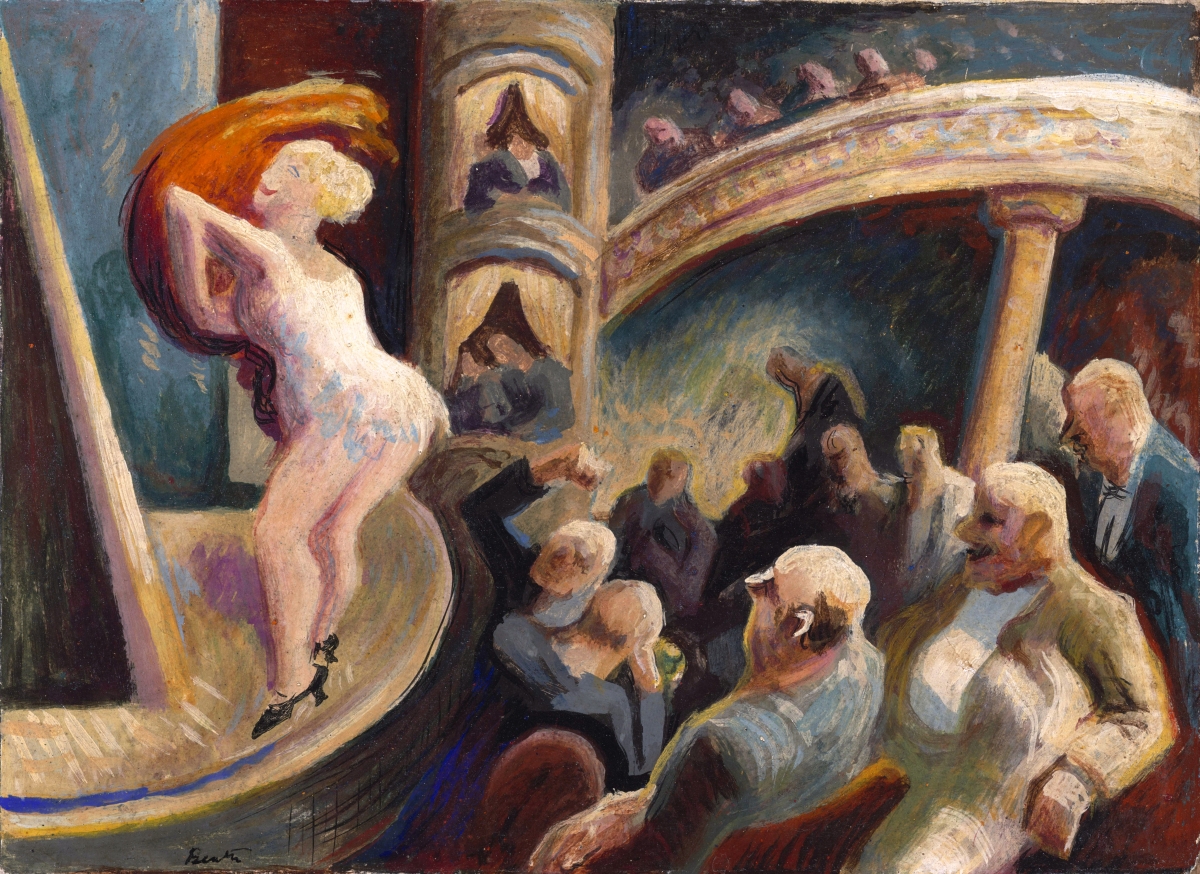
“Portrait of James Baldwin” by Beauford Delaney (1901–1979), 1945, oil on canvas, 22 by 18 inches. Philadelphia Museum of Art: 125th anniversary acquisition, purchased with funds contributed by the Daniel W. Dietrich Foundation in memory of Joseph C. Bailey and with a grant from the Judith Rothschild Foundation.
By Jessica Skwire Routhier
PHILADELPHIA – There are many orthodoxies in the study of American Modernism: that it was centered in New York, that it was primarily a product of photographer/gallerist Alfred Stieglitz and the artists he promoted, that it was defined by a steady move from figuration to abstraction, and that this is best understood through works of painting, sculpture and photography. All these orthodoxies, and more, are subject to scrutiny in “Modern Times: American Art 1910-1950” at the Philadelphia Museum of Art (PMA) through September 3.
Being an orthodoxy, of course, doesn’t necessarily make something wrong; what it does do is distill a complex idea into something more fixed and easily understood, something that takes the form of inherited knowledge and that believers are often then reluctant to interrogate. And yet, such interrogations have the potential to enrich one’s understanding in ways that do not necessarily involve a crisis of faith. To reverse the metaphor and use religion as an example: you may or may not, for instance, subscribe to the doctrine of the direct intercession of saints, but, in any case, your understanding might be enriched by historical and theological inquiry into whether intercession means exactly what you think it means, or if the saints are exactly who you assume them to be. Similarly, “Modern Times” does not propose to discredit the orthodoxies of American Modernism – there is no effort, for instance, to somehow place Philadelphia above New York in terms of influence – only to complicate them and, in so doing, reveal the inherent complexity of this chapter of American art.
To that end, it seems only vaguely ironic that curator Jessica Todd Smith says she thinks of two New York artists as “patron saints of American Modernism in Philadelphia” – Stieglitz and Georgia O’Keeffe. The reason is connected to how Stieglitz’s collection came to be at the PMA, where today it forms a cornerstone of the museum’s collections in this area. Smith relates how on his 80th birthday, early in 1944, Stieglitz asked O’Keeffe, his life partner, to manage the dispersal of his estate after his death. While grappling with this intimidating task – Stieglitz’s art collection was just as large and important as you would expect the leading gallery owner of Twentieth Century New York’s to be – the couple received a visit from their longtime friend Carl Zigrosser, who happened to be a curator at the PMA. Zigrosser suggested that O’Keeffe get organized by hanging the collection in the galleries of the PMA, thus getting things out of storage and giving her “an opportunity to sort things out while Stieglitz is still alive,” says Smith. “Zigrosser had a distinctive position in having a very large building that wasn’t completely built up on the inside,” she adds, noting that while the main building was completed in 1928, the interior spaces were not divided and finished until some years later. “So they were able to be really nimble because they had these empty spaces. By July, more than 300 objects were on view at the PMA from the Stieglitz collection.” Little surprise, then, that upon Stieglitz’s death two years later, O’Keeffe chose the PMA to be one of the six primary beneficiaries of his estate.
 Interestingly, the shifting shape of the PMA’s campus is once again in play with the presentation of the current exhibition. The museum is in the midst of a large-scale expansion project that officials are calling the Core Project – a new building by architect Frank Gehry will add some 90,000 additional square feet of public and exhibition space – and because of that, the galleries in which works of American Modernism are usually seen are behind construction barricades. It is a measure of the importance that the museum – and Philadelphia itself – places on American art of the Twentieth Century that it has dedicated its extensive special-exhibition galleries to showing those works from its collection throughout the summer months.
Interestingly, the shifting shape of the PMA’s campus is once again in play with the presentation of the current exhibition. The museum is in the midst of a large-scale expansion project that officials are calling the Core Project – a new building by architect Frank Gehry will add some 90,000 additional square feet of public and exhibition space – and because of that, the galleries in which works of American Modernism are usually seen are behind construction barricades. It is a measure of the importance that the museum – and Philadelphia itself – places on American art of the Twentieth Century that it has dedicated its extensive special-exhibition galleries to showing those works from its collection throughout the summer months.
“I never had the opportunity to look at Modernism through the prism of Philadelphia, and particularly through the PMA’s collections” before joining the museum’s staff just two years ago, said Smith. “I was so interested to learn how very invested the PMA was in Modernism from its earliest years,” she adds, noting that director Fiske Kimball was collecting with ambition and perseverance in the 1930s, 1940s and 1950s. It may surprise some viewers, as it did Smith, to learn how many well-known Modernists are natives of the city – Alexander Calder, Stuart Davis, Man Ray, Alice Neel – and how many more have significant connections there, often because of having studied at the Pennsylvania Academy for the Fine Arts (PAFA). But it is the lesser-known artists, many of them Philadelphians, that offer up some of the strongest and most surprising challenges to Modernism’s orthodoxies, all the more so because Smith has taken care not to sequester them but instead has integrated them fully into her thematic installation.
“I really didn’t want to have ‘Here’s the Stieglitz artists and here are the artists you haven’t heard of,'” says Smith, noting that her installation strategy was instead one of “resonant pairings.” An early abstraction by Georgia O’Keeffe, for instance, appears next to a visually related painting by the largely forgotten Edith Clifford Williams; scenes from interracial speakeasies by African American artists like Claude Clark are placed alongside the misbehaving white businessmen of a Thomas Hart Benton burlesque scene. The former pairing is related to the “Rhythm, Light and Sound” section of the exhibition; the latter to “Modern Life.” Other sections are “Close Up on Still Life,” “A Modern Palette,” “Nature Abstracted,” “Urban Geometry” and “The Animated Figure.” The same sections are repeated in the organization of the book produced in conjunction with the exhibition, though it is technically not an exhibition catalog and is meant, in Smith’s words, as more of an “evergreen” publication celebrating the PMA’s collection of American Modernism.

“Burlesque” by Thomas Hart Benton (1889–1975), circa 1922, tempera on panel, 9½ by 12½ inches. Philadelphia Museum of Art, bequest of Edward Suckle, MD.
Smith points to the “A Modern Palette” section as particularly illustrative of her aims for the exhibition. Vivid, Fauve-inspired color emerged as a theme when she gathered together the work of several Philadelphia artists like Hugh Henry Breckenridge, Arthur Beecher Carles and Henry McCarter – largely unknown today outside of the city – and realized how well their vibrantly colored works complemented one another. This is partly due to teacher-student relationships among the artists, but is also, Smith argues, a visible feature of Modernism in Philadelphia. While reluctant to identify set hallmarks of a “Philadelphia style,” Smith notes that one thing all artists associated with the city shared was ready access to world-class collections at the PMA, PAFA and the Barnes Foundation, the latter of which developed a reputation for cultivating young African American artists like Horace Pippin and Aaron Douglas, whose works are also on view. The Barnes was also known for its collection of work by Henri Matisse; the French artist’s famous mural “The Dance II” was installed there in 1932, and his colorful, nature-inspired influence is seen not only in paintings by the above artists but also in a printed textile by Philadelphian June Groff, which Smith identifies as an especially meaningful inclusion in the show. “She studied at PAFA and clearly absorbed lessons about color and gesture from the community there, so the piece fits neatly into that modern palette but brings a woman and another Philadelphian into the conversation.”
And, of course, an artist whose primary medium was textile design. Through such savvy inclusions, Smith’s exhibition demonstrates an earnest attempt to expand outward from the trinity of painting, sculpture and photography that has held such canonical sway over the history of American Modernism for so long. Also included are examples of fashion, printmaking and decorative arts, including a shimmering Art Deco chrome-and-Bakelite cocktail shaker. Smith says that she thinks visitors have been particularly responsive to the groupings she has assembled, noting in particular a pairing of an untitled, shaped canvas by Charles Green Shaw, abstract but “clearly inspired by the built environment,” hung above a skyscraper-themed bookcase by Paul Frankl. Next to them is an Art Deco screen by Donald Deskey, and then a dress that has a very similar form. Nearby is a selection of photographs that take skyscrapers as their subjects. “It gives me so much pleasure to see people walk into the exhibition and see this platform and say, ‘Oh, I get it,'” says Smith – in other words, when visitors begin to understand, in a visual sense, that Modernism was a subject as well as a style, and that it was often both things simultaneously; that the movement embraced everything from flower gardens to skyscrapers, high society to gin joints, pure abstraction to representational portraiture; and that it both coalesced in meaningful ways around New York and often enough had nothing to do with New York, or with any recognizable city. Both – all of these things – can be true at the same time.
“It’s such a dynamic period,” says Smith. “That pushing against convention, that trial and error – it’s not always a neat process.” She recalls that, working virtually on her computer screen, she conducted her own trial-and-error experiment with the checklist for the show, lining every work up according to the strict chronology of when it was produced. “It looked like a hot mess,” she recalled, persuasive evidence that there really is no simple narrative, no “linear march from figuration through abstraction,” not even within single artists’ work – she points to both O’Keeffe and Marsden Hartley as examples of artists whose work defies such teleologies. By grouping things thematically, she says, she was better able to “show the similarities and differences in how artists were responding to the art-historical canon.”
Among the lessons of the show are two challenging but resilient ideas. First, Modernism, however one ultimately defines it, bled into every aspect of early Twentieth Century life in a way that other arts movements did not. And second, Modernism itself was far more diverse and is far less easy to define than even some of its most ardent practitioners, patrons and scholars might yet believe.
“Modern Times: American Art 1910-1950” is accompanied by a lavishly illustrated book titled American Modernism: Highlights from the Philadelphia Museum of Art, published by the PMA, with an essay by Smith and 110 pages of color plates.
The Philadelphia Museum of Art is at 2600 Benjamin Franklin Parkway. For information, 215-763-8100 or www.philamuseum.org.
Jessica Skwire Routhier is managing editor of Panorama, the journal of the Association of Historians of American Art. She lives in South Portland, Maine.



















